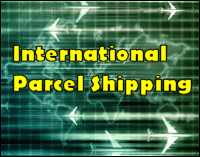Wednesday, November 14, 2012
International Shipping Tips – Part 2
With international shipping comes customs forms creation. Maybe you do this through your shipping software, maybe you create your own forms, or you might use an online system or some other way to do this. Without the correct forms, your packages will not be delivered, so this is important. Customs forms have to meet certain specs and need to contain specific information, since most customs data must also be presented to customs electronically. This information includes a description of the goods in the shipment, their value, its classification (a merchandise sale, gift, documents only, etc.), and accurate customs Schedule B and Harmonized Tariff codes so that your packages clear customs without delays.
Since “Schedule B and Harmonized Tariff codes” are unfamiliar terms for some, below is information about the Schedule B codes from the US Census Bureau, plus some information about Harmonized Tariff codes. You can get additional information about these codes at the US Census Bureau website: http://www.census.gov/foreign-trade/schedules/b/.
Millions of trade transactions occur each year. These transactions are classified under approximately 8,000 categories of products leaving the United States and every exported item is assigned a unique 10-digit identification code. For example, concentrated frozen apple juice is assigned a 10-digit identifier that is in a broader category that is assigned a 6-digit identifier for apple juice. The 6-digit identifier for apple juice is in another broader category assigned a 4-digit identifier for fruit juices, vegetable juices, etc. The 4-digit identifier is in another broader category assigned a 2-digit identifier for Preparations of Vegetables, Fruit, Nuts etc. When you export goods, it may take some studying to learn which of these codes are the right codes for your product(s).
What's the difference between the Schedule B codes (for exports) and the Harmonized Tariff Schedule (HTS) codes (for imports)? All of the import and export codes used by the United States are based on the Harmonized Tariff System (HTS) - http://www.usitc.gov/tariff_affairs/. The HTS assigns 6-digit codes for general categories. Countries that use the HTS are allowed to define commodities at a more detailed level than 6-digits, but all definitions must be within that 6-digit framework. The U.S. defines products using 10-digit HTS codes, like the example for concentrated frozen apple juice. Export codes (which the U.S. calls Schedule B) are administered by the U.S. Census Bureau. Import codes are administered by the U.S. International Trade Commission (USITC).
The USPS uses forms called 2976 or 2976A to record and print this information. UPS and FedEx use a commercial invoice. Regardless of which form or carrier is used, your products must be properly documented or your package will sit at customs until clarification is provided. With the requirements for electronic upload of customs information, customs form creation is being tied more and more to the shipping system. Our CPS Shipping Software creates and prints the necessary customs forms; so as a multi-carrier shipping system, CPS users have one easy system for international shipping and documentation.
We'll get into more about international customs forms in an upcoming post. For more information about CPS, visit www.HarveySoft.com.
Subscribe to:
Post Comments (Atom)


5 comments:
This is something I definitely know very little about, so thanks for digging into it. While it doesn't seem immediately relevant to the self storage industry, some of the natural branch outs of storage itself can involve this sort of process.
Software applications play a crucial role in the pallet delivery industry. So, thank you for these tips. It can help make deliveries more efficient. :)
This is really interesting post. Never thought that it was this simple after all. I had spent a good deal of my time looking for someone to explain this subject clearly and you’re the only one that ever did that. Keep it up
Thanks,
Canadian shipping company
Transportation services provide Reefer Trucking, Hazmat Trucking, and LTL & FTL trucking services to Newfoundland depending upon the weight of cargo to be delivered there.
Thank you very much and will look for more postings from you.
excess baggage shipping
Post a Comment